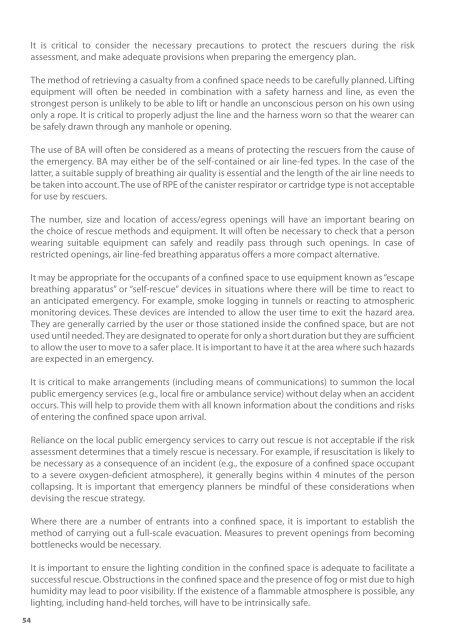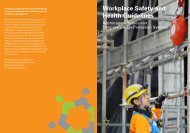Confined Spaces - Workplace Safety and Health Council
Confined Spaces - Workplace Safety and Health Council
Confined Spaces - Workplace Safety and Health Council
- No tags were found...
You also want an ePaper? Increase the reach of your titles
YUMPU automatically turns print PDFs into web optimized ePapers that Google loves.
It is critical to consider the necessary precautions to protect the rescuers during the riskassessment, <strong>and</strong> make adequate provisions when preparing the emergency plan.The method of retrieving a casualty from a confined space needs to be carefully planned. Liftingequipment will often be needed in combination with a safety harness <strong>and</strong> line, as even thestrongest person is unlikely to be able to lift or h<strong>and</strong>le an unconscious person on his own usingonly a rope. It is critical to properly adjust the line <strong>and</strong> the harness worn so that the wearer canbe safely drawn through any manhole or opening.The use of BA will often be considered as a means of protecting the rescuers from the cause ofthe emergency. BA may either be of the self-contained or air line-fed types. In the case of thelatter, a suitable supply of breathing air quality is essential <strong>and</strong> the length of the air line needs tobe taken into account. The use of RPE of the canister respirator or cartridge type is not acceptablefor use by rescuers.The number, size <strong>and</strong> location of access/egress openings will have an important bearing onthe choice of rescue methods <strong>and</strong> equipment. It will often be necessary to check that a personwearing suitable equipment can safely <strong>and</strong> readily pass through such openings. In case ofrestricted openings, air line-fed breathing apparatus offers a more compact alternative.It may be appropriate for the occupants of a confined space to use equipment known as “escapebreathing apparatus” or “self-rescue” devices in situations where there will be time to react toan anticipated emergency. For example, smoke logging in tunnels or reacting to atmosphericmonitoring devices. These devices are intended to allow the user time to exit the hazard area.They are generally carried by the user or those stationed inside the confined space, but are notused until needed. They are designated to operate for only a short duration but they are sufficientto allow the user to move to a safer place. It is important to have it at the area where such hazardsare expected in an emergency.It is critical to make arrangements (including means of communications) to summon the localpublic emergency services (e.g., local fire or ambulance service) without delay when an accidentoccurs. This will help to provide them with all known information about the conditions <strong>and</strong> risksof entering the confined space upon arrival.Reliance on the local public emergency services to carry out rescue is not acceptable if the riskassessment determines that a timely rescue is necessary. For example, if resuscitation is likely tobe necessary as a consequence of an incident (e.g., the exposure of a confined space occupantto a severe oxygen-deficient atmosphere), it generally begins within 4 minutes of the personcollapsing. It is important that emergency planners be mindful of these considerations whendevising the rescue strategy.Where there are a number of entrants into a confined space, it is important to establish themethod of carrying out a full-scale evacuation. Measures to prevent openings from becomingbottlenecks would be necessary.It is important to ensure the lighting condition in the confined space is adequate to facilitate asuccessful rescue. Obstructions in the confined space <strong>and</strong> the presence of fog or mist due to highhumidity may lead to poor visibility. If the existence of a flammable atmosphere is possible, anylighting, including h<strong>and</strong>-held torches, will have to be intrinsically safe.8.5 Training of Rescue PersonnelIt is important for any person appointed to carry out any emergency arrangements to receiveappropriate instruction <strong>and</strong> training to enable him to perform that role effectively. Such trainingincludes first aid, CPR, the proper use of PPE <strong>and</strong> other equipment necessary for carrying out therescue operation <strong>and</strong> as an authorised entrant. The level of training will vary according to thecomplexity <strong>and</strong> skill content of the role. It is necessary to conduct refresher training as often aspossible to maintain an acceptable level of competence.Familiarity with procedures <strong>and</strong> equipment is essential. It can be developed <strong>and</strong> fine-tuned byfrequent drills <strong>and</strong> realistic simulation.All rescue personnel need to underst<strong>and</strong> the likely causes of an emergency. They will need tobe familiar with the rescue plan <strong>and</strong> procedures developed for each type of confined spacethat they may encounter. They need to be able to rapidly size-up an emergency situation <strong>and</strong>evaluate their ability to conduct a safe rescue. These factors need to be given consideration in thedevelopment of a training programme. It is important to design the training in such a way thatrescuers are capable to perform rescues in a safe <strong>and</strong> timely manner.Rescuers need to be fully familiar with the equipment for use in rescue, communications ormedical purposes <strong>and</strong> operation. They would need to check that the equipment is functioningwell before use. It is important for potential users of breathing apparatus to receive appropriateformal training. It is critical for trained persons to carry out the resuscitation procedures efficiently.Designated first-aiders need appropriate current certification.It is necessary to evaluate the capability of rescuers <strong>and</strong> others involved in the emergencyarrangement using objective criteria. It is important for trainers <strong>and</strong> instructors to be appropriatelyqualified <strong>and</strong> experienced to carry out their roles effectively.8.6 Provision of Rescue EquipmentSuitable <strong>and</strong> sufficient rescue equipment is needed to respond to an emergency in a timely <strong>and</strong>safe manner. It is important to list the appropriate equipment for the likely type of emergenciesin the risk assessment. It is crucial to maintain the rescue equipment properly <strong>and</strong> make themreadily available whenever <strong>and</strong> wherever confined space work is undertaken.For example, rescue equipment may include:• Full body harness with retrieval line attached;• H<strong>and</strong>-cranked mechanical winch <strong>and</strong> tripod (required when entrant is five feet or morebelow the entrance);• Ladder;• Explosion-proof lighting;• Breathing apparatus;• Stretcher;• Approved head protection; <strong>and</strong>• Resuscitating apparatus.54 55
















